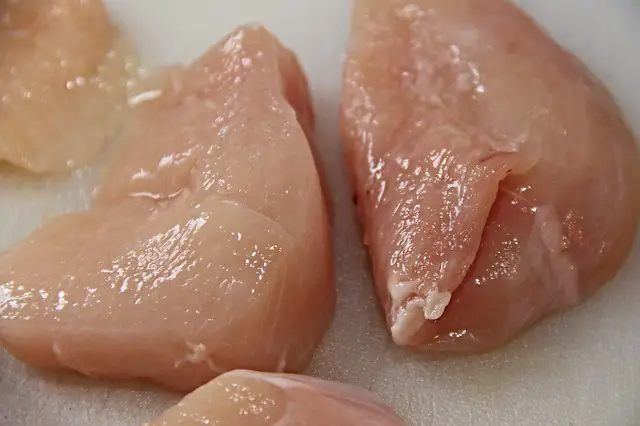
If you’re one to check your pet food for the ingredients on the pack, and you should, you’ve probably come across the words “crude protein.” But have you ever wondered “what is crude protein in dog food?” Or do you just assume that it is same ole protein. You might be surprised at what you find by simply trying to find out and that’s why we’re glad you asked.
Table of Contents
First, What Are Proteins?…
…Because, crude protein, at the heart of it, is just protein. Of course, there’s more to crude protein than this but we move from the known to the unknown.
Proteins, known as the building blocks of life, contain smaller useful nutrients known as amino acids. These amino acids are 22 in number and ten of them are considered essential while the other 12 are considered non-essential.
So, what’s the difference between the essential amino acids and the non-essential ones?
Essential amino acids are not produced naturally by the body. Hence, man and animals must consume it from the food they eat to grow healthy.
On the other hand, there are the non-essential amino acids which are naturally synthesized in the body.
So, What Is Crude Protein… In Dog Food And Generally?
The use of crude protein has actually been in existence for centuries, literally.
It was first developed by Henneberg and Stohmann at the Weende Experiment station as far back as 1860. It was developed as a small part of a much broader process used to classify animal feed at the time.
The crude protein test was developed to chemically determine the amount of nitrogen in the food in question. When this value is gotten, it is then multiplied by 6.25 (because it was assumed at the time that proteins contain 16% nitrogen). The result of this multiplication is, therefore, what is known as the percentage of crude protein contained in the food being analyzed.
Is The Crude Protein Method Still Relevant Today?

Well, this is a critical question considering that this method was developed over a hundred years ago. Advancements in nutrition and science generally have literally exploded since then.
There are far better, more modern, and more sophisticated ways to understand the nutritional requirements of pets and other animals these days.
Plus, the archaic assumption that protein is 16% nitrogen makes this method even more faulty. The nitrogen content in protein isn’t constant. Instead, it varies by the amount of amino acids it contains per time.
A better way to determine nitrogen content, therefore, is to analyze the protein source individually for their amino acid profile. For instance, meat and fish have different amino acid profiles, and, therefore, contain different percentages of nitrogen.
Another reason this crude protein method is unreliable is that proteins can also contain nitrogen from non-protein sources. The crude protein method does not account for this but science has discovered that this non-protein nitrogen can account for up to 10% of the total nitrogen content in foods. This percentage may vary across foods, though.
So, putting this in mind, it would mean that whatever is presented as the protein content from crude protein analysis should actually be 10% less than the value presented.
Further Proof That The Crude Protein Method Is An Unreliable Method For Comparing Dog Foods

Let’s look at this from the point of view of the synthesis of proteins in a dog’s body. Dogs, humans, and animals, in general, cannot synthesize protein if the food we eat does not contain the full spectrum of the essential acids needed.
Moreover, there’s no single protein source that contains all essential amino acids. So, at every point in time, animals need a variety of protein sources.
Plus, the amount of amino acids required by dogs vary from breed to breed, from age to age and even from gender to gender.
Understanding this, therefore, we begin to see the folly in comparing foods based on their crude protein content. Crude protein tells you nothing, just their nitrogen content which could literally be from any protein source, good or bad.
Plus, crude protein tells you nothing of the amino acid profile of the food in question. Just how many of these essential amino acids does this food contain? Crude protein levels cannot answer that question.
So, you can’t just say that two foods are of the same quality just because they have the same crude protein content without comparing their amino acid profile to see just how much essential acids they actually contain and if they meet your dog’s physiological requirement.
The Dangers Of The Crude Protein Method
By law, manufacturers are required to include the crude protein on the label of their foods, both for animals and for humans. However, this has proved to be a disaster as proved by the fiasco that happened in China, 2008.
Baby formula was being contaminated with melamine – a plastic that’s rich in nitrogen. As you can guess, it was added to the formula to increase nitrogen content to get a good “crude protein score.” Of course, they got what they wanted, deceived unsuspecting law enforcement agents as well as customers and sold their products by the truckload.
Unfortunately, it was innocent babies that paid the price. 6 babies died from kidney damage, while about 54,000 others were hospitalized.
There have also been cases where urea (a fertilizer that’s rich in non-protein nitrogen) was added to animal feed just to get a good crude protein score for the labels and sell more products.
Sadly, urea and melamine are toxic for the consumption of animals with a single compartment stomach. Thankfully, they are both on the banned food ingredient list for man and animals, but then again, it hasn’t stopped the most notorious of manufacturers.
Nonetheless, this only goes to show, even more, why the crude protein method is not just an unreliable method but a potentially dangerous one as well.
To put things in perspective, including a missing amino acid will actually improve the quality of a particular food. However, this inclusion does not always reflect in an increase in the crude protein content.
On the other hand, when unbalanced food has a high crude protein, it could cause an interruption in protein synthesis, as well as stunt growth and health just like we saw in the scenario above.
So, If We Can’t Use Crude Protein To Judge, How Do We Select A Good Dog Food For Our Dogs?
Thankfully, there are better, more reliable methods we can use to judge how good or otherwise a dog food is.
1. Read The Label

Is the manufacturer general in their description of the food or are they specific? You want to pick a food that lists a named whole meat as the first ingredient. That could be lamb, chicken, or salmon.
This way, you don’t end up with a food that’s packed with ingredients used to boost nitrogen levels rather than quality protein sources.
2. Look Out For A Diverse Ingredient List
A truly nutritious food must contain a diverse list of ingredients that cater to your dog as well as the microorganisms in the gut. If the microorganisms in the body are not well-fed, it would be almost impossible for the body of an animal to be able to utilize the nutrients in the food we eat.
[amalinkspro type=”showcase” asin=”B07L97GQW5″ apilink=”https://www.amazon.com/dp/B07L97GQW5?tag=dpg-amalinks03-20&linkCode=osi&th=1&psc=1″ new-window=”true” addtocart=”true” nofollow=”true” sc-id=”4″ imgs=”LargeImage” link-imgs=”false” specs=”Taste of the Wild High Prairie with ROASTED BISON & VENISON REAL MEAT is #1 ingredient optimal amino acid profile & protein rich for LEAN STRONG MUSCLES~~~High protein ingredients with added vitamins & minerals fruits and vegetables as SUPERFOODS for hard-working ANTIOXIDANTS fatty acid blend for SKIN & COAT~~~Ingredients From Trusted Sustainable Sources Around The World Made With No Grain Corn Wheat Filler No Artificial Flavors Colors Preservatives Added~~~Nutrient rich and HIGHLY DIGESTIBLE with species-specific PROPRIETARY PROBIOTICS that survive and thrive in the GI tract~~~MADE in the USA FAMILY OWNED & run food made with the most scientifically advanced food safety protocols Wed appreciate your CALL 800 342 4808~~~” btn-color=”#ff9900″ btn-text=”View on Amazon” alignment=”aligncenter” hide-prime=”0″ hide-image=”0″ hide-reviews=”0″ hide-price=”1″ hide-button=”0″ width=”750″]Taste of the Wild High Protein Real Meat Recipe Premium Dry Dog Food with Roasted Bison and Roasted Venison[/amalinkspro]
3. Focus On The Whole Food Not Just A Couple Of Ingredients
In many pet foods, you find that the manufacturers hap on the health benefits of just one or two ingredients rather than the whole food. Consider that a red flag. Your dog needs a balanced diet to be well-nourished not just one or two super ingredients.
4. Monitor Your Dog’s Nutrition And Health
Even after following all these steps, it’s still important to monitor how your dog thrives on any diet he’s currently on. If your dog appears to be doing better, great. If he appears to be deteriorating, poor skin and fur health, poor muscle development, then that’s indicator enough that that food isn’t good for your dog.
Also, don’t be shy to ask other dog parents with obviously healthy dogs what they fed their pups as well. You might actually get a recommendation that works.
In all, you must consult your vet before changing your pup’s diet willy-nilly. Experimenting with your dog’s food, oftentimes, does more harm than good to your dog.
5. Call The Company If You Have Questions About Any Protein Listed Among The Ingredients
If you have questions, try to get in contact with the nutritionists (not the salespeople) of the company. Most of them are passionate about pet health and will help you with what you should know rather than what they want you to hear.
This video explains how to select a good dog food among the many terrible dog foods out in the market. Eric Letendre especially zeroes in on how to read the ingredient label of dog foods.
You Can Still Check The Crude Protein Level On Dog Foods
“I thought we just discredited the crude protein in not too few words?” Well, yeah, we did. Nonetheless, even with the shortcomings of the crude protein method, there is still some small merit to it, as long as it’s not considered in isolation.
The best way to use crude protein levels as an indicator is to consider it alongside all the points we listed above.
Generally, shady manufacturers try to drive down production costs by trying not to include enough protein even when it’s obvious that’s there’s a shortage of amino acids. This will show up in crude protein levels.
But as we said, you must not consider it in isolation because we’ve seen that some manufacturers would do anything to increase their crude protein. However, if crude protein is outright low, then you are definitely dealing with a food that’s lacking in protein.
So, as long as you use it right, checking crude protein levels can help you pick out good dog food.
For more information on protein and dog foods, click here to read our article on high protein dog foods.
Conclusion
Crude protein is a general assement of the total amount of protein a food contains based on the nitrogen levels of the food. It does not take into account the source of the nitrogen in its estimation. So, while crude protein levels might be high which, supposedly, indicates a good food, the protein might have been sourced from anything, good or toxic.
However, it’s not a totally useless standard of measuring dog foods as long as it’s not used in isolation.